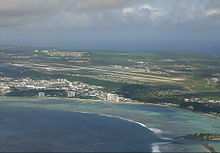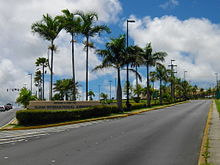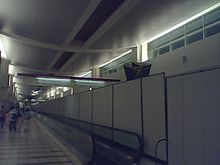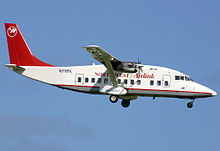- Antonio B. Won Pat International Airport
-
Guam International Airport
Antonio B. Won Pat International Airport
IATA: GUM – ICAO: PGUM – FAA LID: GUM Location of the Airport in Guam Summary Airport type Public Owner A.B. Won Pat International Airport Authority, Guam Serves Guam Location Barrigada and Tamuning, Guam Hub for - Asia Pacific Airlines
- Continental Airlines
Elevation AMSL 297 ft / 91 m Coordinates 13°29′02″N 144°47′50″E / 13.48389°N 144.79722°E Website Runways Direction Length Surface ft m 6L/24R 10,015 3,053 Asphalt/Concrete 6R/24L 10,014 3,052 Asphalt/Concrete Statistics (2006, 2010) Aircraft operations (2006) 36,948 Based aircraft (2006) 74 Passengers (2010) 2,807,205 Source: Federal Aviation Administration[1], Airport Website[2] Antonio B. Won Pat International Airport (IATA: GUM, ICAO: PGUM), also known as Guam International Airport, is an airport located in Tamuning and Barrigada,[3] three miles east of the capital city of Hagåtña (formerly Agana) in the U.S. territory of Guam. It is named for Antonio Borja Won Pat, the first delegate from Guam to the United States House of Representatives, and is operated by the A.B. Won Pat International Airport Authority, Guam (GIAA, Chamorro: Aturidat Puetton Batkon Airen Guahan Entenasionat),[4] an agency of the Government of Guam.
The airport is a hub for Continental Airlines. Following the merger of Continental and United Airlines, the airport will become the ninth largest hub for United. The airport is also the hub for Asia Pacific Airlines.
The airport is also the home of the former Naval Air Station Agana.
Contents
History
Main article: Naval Air Station AganaMilitary use
The airport was built by the Japanese Navy about 1943, calling the military airfield Guamu Dai Ni (Guam No. 2) as part of their defense of the Marianas. After the island was recaptured by American forces in 1944, it was renamed Agana Airfield, due to the proximity of the town. After being repaired in October 1944, the United States Army Air Force Seventh Air Force used the airfield as a base for the 11th Bombardment Group, which flew B-24 Liberator bombers from the station until being moved to Okinawa in July 1945. With the reassignment of the heavy bombers, the 41st Photographic Reconnaissance Squadron flew long-range reconnaissance aircraft (F-4 P-38 Lightnings) from the field until January 1946.
After the war, the USAAF used the airfield for fighter defense of the Marianas (21st Fighter Group), (549th Night Fighter Squadron) until early 1947 and as a transport hub (9th Troop Carrier Squadron). In 1947, the USAAF turned over the airfield to the United States Navy, which consolidated its facilities with those at the closing Harmon Air Force Base in 1949, and operated Naval Air Station, Agana until it was closed by the 1993 Base Realignment and Closure (BRAC) Commission.[5][6][7]
Civilian use
Operations of the civilian terminal (Guam International Air Terminal) was passed onto the Government of Guam's Department of Commerce in 1969. In 1975, the Guam International Airport Authority (GIAA) was created as a separate agency. After NAS Agana was closed in April 1995, GIAA took over the entire airport's operations.[8]
The first passenger terminal building was opened in 1982. The current, much larger terminal building was opened in phases between 1996 and 1998.[9]
A Houston Chronicle article in 2008 stated that expected subsequent military buildup and population growth could lead to an expansion of flights to and from the airport.[10]
Customs, immigration, and security inspections
Arrival passenger inspection is conducted by the U.S. Customs and Border Protection (CBP, immigration only) and Guam Customs & Quarantine Agency (GCQA). Departure security checks are conducted by the U.S. Transportation Security Administration (TSA).[11]
Customs
Since Guam is outside the United States customs jurisdiction, passengers from all arrival flights go through GCQA inspection. Passengers bound for Honolulu (currently the only Stateside flight) go through a normal USCBP customs inspection upon arrival.
Immigration
The USCBP inspects all arriving passengers except nonstop flights from the States. Passengers arriving from the U.S. Commonwealth of the Northern Mariana Islands (CNMI) also have to go through USCBP inspection as the Northern Marianas are a separate U.S. immigration jurisdiction. For U.S. citizens, passports are not required to enter Guam from the CNMI (i.e., other forms of ID proving admissibility are accepted), but are required for those transiting a foreign country between the States and Guam.
The USCBP also conducts a pre-clearance of nonstop passengers bound for Honolulu. Because of the Guam & CNMI Visa Waiver Program, which gives tourists from certain Asian countries visa-free entry (to Guam and the CNMI but not the States), Honolulu-bound passengers are inspected for their admissibility to the U.S.
Transit passengers (except from Honolulu) are also inspected by the USCBP before being allowed to proceed to their connecting gate. However, since there is no need to clear Guam customs, no baggage claim is necessary.
Security
The TSA conducts security inspection for all departing passengers and all transit passengers not arriving from the States and the CNMI, which are already screened by TSA at their origins. However, Guam-Honolulu passengers who have onward connections must go through TSA inspection again in Honolulu because they will have come into contact with their checked baggages during U.S. customs inspection there.
Passenger terminal
The current passenger terminal's first phase was completed on September 10, 1996. The 550,000-square-foot (51,000 m2) terminal included a new customs and immigration hall and a 710 lot parking space. In August 1998 the second phase of the current passenger terminal opened.[12] The expansion program that opened the current terminal had a cost of $741 million.[9] The terminal has three levels. The basement level houses arrival facilities, including customs and baggage claim. The basement also houses the GIAA Airport Police and GIAA Arcade offices and the Hafa Adai Gardens. The apron level (the departure level) houses the ticketing counters. The third floor houses the departure gates, immigration facilities, and GIAA administrative offices.[13]
Terminal design problem post 9/11
Since all flights require customs or immigration inspection, the airport's post-security concourse and gate area was not designed to separate arriving and departing passengers. The only normal passenger entrance is through security and the only normal exit is through immigration. Except for the few gates designated for Honolulu arrivals, which route passengers directly to customs, all other gates do not have a separate arrival corridor. Arrival passengers walk directly into the gates waiting area, and in the past could actually purchase food or merchandises before entering the immigration hall.
The original design is said to be compliant with security standards at the time of opening. However, after the September 11 attacks in 2001, the U.S. government began to require separation of uninspected arrival passengers. The airport initially used a system of chairs, moving sidewalks, retractable belts and security/police staffing to usher arriving passengers from the gate to the immigration hall without coming into physical contact with departing passengers. In recent years, semi-permanent movable walls separate much of the length of the terminal building into two halves, decreasing the need for human staffing and those lighter objects previously in use.
Old terminal building
Old terminal - Continental Micronesia headquarters
The old terminal served as the corporate headquarters of Continental Micronesia until late 2010.[14] The 220,000-square-foot (20,000 m2),[12] $43 million Commuter Terminal was dedicated on January 19, 1982.[12] At the time of opening, the Guamanian people referred to the terminal as a "white elephant," believing that the terminal was so large that it would never be fully used.[9] After the current terminal building opened, the old terminal building became the Commuter Terminal (serving Freedom Air and Pacific Island Aviation).[citation needed] By 2003 the Guam International Airport Authority moved commuter airlines out of the Commuter Terminal and leased the entire facility to Continental.[15]
Other facilities
The Continental Micronesia Cargo Warehouse is between the main terminal and the commuter terminal.[16]
Airlines and destinations
 Boeing 767-400 of Continental Airlines
Boeing 767-400 of Continental Airlines
Airlines Destinations China Airlines Taipei-Taoyuan Continental Airlines Cairns, Chuuk, Fukuoka, Hiroshima, Hong Kong, Honolulu, Koror, Kosrae, Kwajalein, Majuro, Manila, Nagoya-Centrair, Naha, Niigata, Okayama, Osaka-Kansai, Pohnpei, Sapporo-Chitose, Sendai, Tokyo-Narita, Yap Continental Connection
operated by Cape AirRota, Saipan Delta Air Lines Nagoya-Centrair, Osaka-Kansai, Tokyo-Narita Fly Guam
operated by Sky King, Inc.Koror, Saipan[17] Freedom Air Rota, Saipan EVA Air Taipei-Taoyuan Japan Airlines Tokyo-Narita Jin Air Seoul-Incheon Korean Air Osaka-Kansai, Seoul-Incheon
Seasonal: BusanPhilippine Airlines Manila United Airlines Chicago-O'Hare, Honolulu, Tokyo-Narita Accidents
Several fatal accidents have occurred on and near Guam over the years. In total, 367 deaths occurred from 6 different aircraft accidents. The most recent accident occurred in 1997, when Korean Air Flight 801, a Boeing 747, crashed as it was attempting to land at the airport.
For a comprehensive list of all accidents relating to Guam, visit the Aviation Safety Network database by linking to it from the external links section below.
On June 10, 2009, Jetstar Airways Flight 20 flying from Kansai International Airport to Gold Coast Airport experienced a small fire in the cockpit apparently caused by a fault in the heating system. The fire was quickly extinguished by the pilots who subsequently diverted the plane to Guam. All 203 people on board were unharmed in the incident. Jetstar and the Australian Transport Safety Bureau are currently examining the full cause of the fire.[18]
References
 This article incorporates public domain material from websites or documents of the Air Force Historical Research Agency.
This article incorporates public domain material from websites or documents of the Air Force Historical Research Agency.- ^ FAA Airport Master Record for GUM (Form 5010 PDF), retrieved 2007-03-15
- ^ [1]
- ^ "CBC66010_009.pdf." U.S. Census Bureau. Retrieved on September 1, 2009.
- ^ "Memorandum." Antonio B. Won Pat International Airport Authority. August 31, 2007. Retrieved on October 6, 2010.
- ^ Maurer, Maurer (1983). Air Force Combat Units Of World War II. Maxwell AFB, Alabama: Office of Air Force History. ISBN 0-89201-092-4.
- ^ www.pacificwrecks.com
- ^ www.globalsecurity.org
- ^ http://www.guamairport.com/about-your-airport/history-and-timeline/general-history
- ^ a b c "Expansion Project History." Antonio B. Won Pat International Airport Authority. Retrieved on October 6, 2010.
- ^ Hensel, Bill Jr. "TRANSPORTATION / Carrier stands to gain in Guam / Pacific island expects a population influx as military realigns its forces, and Continental's hub will be there to handle it." Houston Chronicle. Friday May 30, 2008. Business 1. Retrieved on October 2, 2009.
- ^ [2]
- ^ a b c "Timeline." Guam International Airport Authority. Retrieved on October 6, 2010.
- ^ "Terminal Layout." Guam International Airport Authority. Retrieved on October 6, 2010.
- ^ Letter. United States Department of Transportation Office of Aviation Enforcement and Proceedings. May 23, 1997. Retrieved on October 4, 2010. "Continental Micronesia Old Terminal Bldg. P.O. Box 8778-G Tamuning, GU 96931-8778."
- ^ "Fiscal Year 2003 Overview." Guam International Airport Authority at Guam Chamber of Commerce. 3/4. Retrieved on October 13, 2010. "Movement of Operations from Commuter Terminal to Main Terminal As part of our streamlining, the Authority successfully moved the Commuter Terminal operations to the Main Terminal and leased the entire former Commuter Terminal to Continental Airlines."
- ^ "Media Advisory." Government of Guam. December 14, 2006. Retrieved on October 13, 2010.
- ^ [3]
- ^ Emergency landing: fire on board Jetstar flight to Gold Coast - Travel - smh.com.au
External links
- Guam International Airport (official site)
- Guide to Guam Airport
- Resources for this airport:
- Airport information for PGUM at AirNav
- Airport Information and Live Flight Tracker for PGUM at FlightAware
- Recent weather observations for PGUM at NOAA/NWS
- Accident history for GUM at Aviation Safety Network
- FAA Terminal Procedures for GUM, effective 20 October 2011
- FAA Airport Diagram (PDF), effective 20 October 2011
Categories:- Airports in Guam
Wikimedia Foundation. 2010.






